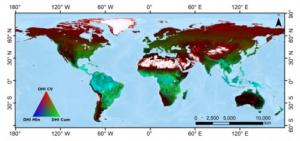A new map for nature: using GPP to predict species richness from space
FAYETTEVILLE, GA, UNITED STATES, July 1, 2025 /EINPresswire.com/ -- A new global study introduces a satellite-based approach for monitoring biodiversity using Dynamic Habitat Indices (DHIs) derived from vegetation productivity data. By analyzing data from multiple satellite products and validating results with in-situ flux tower observations, researchers demonstrated that DHIs based on gross primary productivity (GPP) are powerful predictors of species richness across mammals, birds, amphibians, and reptiles. These findings offer a scalable tool for conservation planning.
Biodiversity is under increasing pressure from habitat loss, climate change, and other human activities. While satellite remote sensing provides crucial insights into global environmental change, translating these observations into conservation-relevant indicators remains a challenge. Traditional methods often rely on indirect proxies like Normalized Difference Vegetation Index (NDVI), which lack precision in capturing true ecosystem productivity. More recently, Dynamic Habitat Indices (DHIs) have emerged as promising tools to link satellite observations to biodiversity. These indices integrate temporal variations in vegetation productivity—such as seasonal abundance, stress, and stability—and are grounded in three ecological hypotheses. Due to these unresolved challenges, more refined tools are needed to effectively link remote sensing data with biodiversity monitoring and conservation outcomes.
A team of researchers from Lanzhou University and collaborating institutions published a study (DOI: 10.34133/remotesensing.0624) on June 2, 2025, in the Journal of Remote Sensing exploring how satellite-derived vegetation productivity can be used to model species richness. The study assessed eight remote sensing datasets, including NDVI, Enhanced Vegetation Index (EVI), fAPAR, and gross primary productivity (GPP), to calculate DHIs and evaluate their correlation with biodiversity patterns at global scales. Their goal was to determine which satellite metrics best reflect global biodiversity patterns and how these tools can enhance conservation decision-making amid accelerating species loss.
The study found that DHIs based on gross primary productivity (GPP), especially those derived from the Vegetation Photosynthesis Model (VPM), significantly outperformed other satellite measures in explaining global patterns of species richness. These GPP-derived DHIs captured up to 84% of the variation in amphibian richness and 82% across all taxa. Compared to indirect measures like NDVI and fraction of Absorbed Photosynthetically Active Radiation (fAPAR), GPP provides a more direct indicator of available energy, environmental stress, and ecosystem stability—three key drivers of species diversity. Importantly, satellite-derived DHIs showed strong alignment with in-situ measurements from 124 FLUXNET sites worldwide, validating their accuracy. Protected areas were found to have higher cumulative and minimum productivity with lower variability, suggesting superior habitat quality. This confirms the utility of DHIs as practical, scalable tools for global biodiversity assessment and conservation planning.
“Our study bridges satellite remote sensing and biodiversity science in a practical way,” said Prof. Xuanlong Ma, corresponding author at Lanzhou University. “By validating satellite-derived habitat indices with ground-based flux tower data, we show that it’s possible to monitor global biodiversity patterns more accurately and cost-effectively. These tools can support urgent conservation efforts worldwide, especially in areas with limited field data. With more advanced satellite missions coming online, we anticipate even finer-resolution biodiversity monitoring in the near future.”
With rising concern over biodiversity loss, this research highlights the potential of satellite-based DHIs derived from direct GPP measures as a standard tool for ecological monitoring. Future improvements may involve integrating higher-resolution imagery from emerging satellites, refining algorithms to reduce uncertainty in low-productivity regions, and expanding biodiversity metrics beyond vertebrates. Combining DHIs with other environmental indicators and species occurrence databases could further enhance conservation modeling. As global satellite infrastructure advances, these tools may enable real-time biodiversity assessment, guiding international efforts to protect critical habitats and meet targets under the UN Convention on Biological Diversity.
References
DOI
10.34133/remotesensing.0624
Original Source URL
https://spj.science.org/doi/10.34133/remotesensing.0624
Funding Information
This work was supported by Director Fund of the International Research Center of Big Data for Sustainable Development Goals [grant number CBAS2022DF006] and the National Natural Science Foundation of China [grant numbers 42171305 and 42311540014] Grant.
Lucy Wang
BioDesign Research
email us here
Legal Disclaimer:
EIN Presswire provides this news content "as is" without warranty of any kind. We do not accept any responsibility or liability for the accuracy, content, images, videos, licenses, completeness, legality, or reliability of the information contained in this article. If you have any complaints or copyright issues related to this article, kindly contact the author above.
Balfour Capital Welcomes Safder Shakil as Investment Advisor
AI That Never Sleeps: Quarero Robotics Unveils Fully Autonomous Solution for 24/7 Smart Surveillance
A' International Cybernetics, Prosthesis and Implant Design Awards Call for Entries
Więcej ważnych informacji
 Jedynka Newserii
Jedynka Newserii

 Jedynka Newserii
Jedynka Newserii

Konsument

Tylko 35 proc. Celów Zrównoważonego Rozwoju ONZ możliwe do osiągnięcia przed 2030 r. Potrzebna ściślejsza współpraca międzynarodowa
Jak wynika z raportu ONZ, choć w ciągu ostatniej dekady dzięki dążeniu do realizacji przyjętych celów udało się poprawić życie milionów ludzi na całym świecie, to jednak tempo zmian pozostaje zbyt wolne, by dało się je osiągnąć do 2030 roku. Postęp hamują przede wszystkim eskalacja konfliktów, zmiana klimatu, rosnące nierówności i niewystarczające finansowanie. Jak wynika ze sprawozdania Parlamentu Europejskiego, problemem jest także brak ścisłej współpracy międzynarodowej i sceptyczne podejście niektórych państw ONZ.
Przemysł spożywczy
UNICEF: Wszystkie dzieci poniżej piątego roku życia w Gazie cierpią z powodu niedożywienia. Sytuacja jest katastrofalna

Ataki Izraela na Strefę Gazy i jej izolacja doprowadziły do całkowitego załamania podstawowych usług i ograniczenia możliwości dostaw i dystrybucji pomocy humanitarnej – wskazuje UNICEF. W efekcie setki tysięcy Palestyńczyków są w sytuacji ciągłego zagrożenia życia i cierpią z powodu niedożywienia i głodu. Ta klęska dotyczy praktycznie wszystkich dzieci poniżej piątego roku życia. Konflikty są jednym z głównych przyczyn braku bezpieczeństwa żywnościowego, głodu i niedożywienia na świecie. Szczególnie dotyczy to Afryki i Azji Zachodniej.
Prawo
Branża ciepłownictwa czeka na unijną i krajową strategię transformacji. Liczy na większe fundusze i korzystne regulacje

Komisja Europejska zapowiedziała rozpoczęcie w I kwartale 2026 roku prac nad strategią dla ciepłownictwa i chłodnictwa. Nad tym strategicznym dokumentem w zakresie ciepłownictwa pracuje także polski rząd. Branża podkreśla, że obie te strategie będą miały kluczowe znaczenie dla trwającej transformacji w ciepłownictwie, czyli przyszłości ogromnych inwestycji, które czekają sektor do 2050 roku. Jednocześnie apeluje o większe wsparcie tego procesu ze środków publicznych.
Partner serwisu
Szkolenia

Akademia Newserii
Akademia Newserii to projekt, w ramach którego najlepsi polscy dziennikarze biznesowi, giełdowi oraz lifestylowi, a także szkoleniowcy z wieloletnim doświadczeniem dzielą się swoją wiedzą nt. pracy z mediami.


![Nestlé w Polsce podsumowuje wpływ na krajową gospodarkę. Firma wygenerowała 0,6 proc. polskiego PKB [DEPESZA]](https://www.newseria.pl/files/1097841585/fabryka-nesquik_1,w_85,r_png,_small.png)






.gif)

 |
| |
| |
|